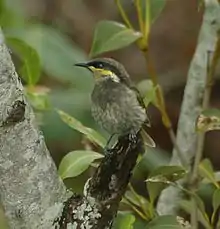Mangrove honeyeater
The mangrove honeyeater (Gavicalis fasciogularis) is a species of bird in the honeyeater family Meliphagidae. The species was once considered to be conspecific with the varied honeyeater, but it is now treated as a separate species. These two species form a genus with the singing honeyeater.
| Mangrove honeyeater | |
|---|---|
 | |
| Scientific classification | |
| Kingdom: | Animalia |
| Phylum: | Chordata |
| Class: | Aves |
| Order: | Passeriformes |
| Family: | Meliphagidae |
| Genus: | Gavicalis |
| Species: | G. fasciogularis |
| Binomial name | |
| Gavicalis fasciogularis (Gould, 1854) | |
| Synonyms | |
|
Lichenostomus fasciogularis | |
It is endemic to Australia, where it is restricted to the eastern coast from Townsville in Queensland to northern New South Wales. The species has been expanding its range southward in recent years. The mangrove honeyeater is generally locally common over most of its range, but is rarer in the south.
Its natural habitat is subtropical or tropical mangrove forests.
The mangrove honeyeater was previously placed in the genus Lichenostomus, but was moved to Gavicalis after a molecular phylogenetic analysis, published in 2011, showed that the original genus was polyphyletic.[2][3]
References
- BirdLife International (2012). "Gavicalis fasciogularis". IUCN Red List of Threatened Species. 2012. Retrieved 26 November 2013.CS1 maint: ref=harv (link)
- Nyári, Á.S.; Joseph, L. (2011). "Systematic dismantlement of Lichenostomus improves the basis for understanding relationships within the honeyeaters (Meliphagidae) and historical development of Australo–Papuan bird communities". Emu. 111 (3): 202–211. doi:10.1071/mu10047. S2CID 85333285.
- Gill, Frank; Donsker, David (eds.). "Honeyeaters". World Bird List Version 6.1. International Ornithologists' Union. Retrieved 28 January 2016.
| Wikimedia Commons has media related to Gavicalis fasciogularis. |
| Wikispecies has information related to Lichenostomus fasciogularis. |
